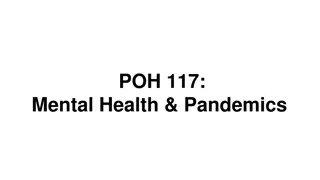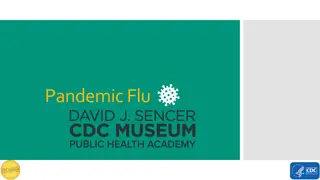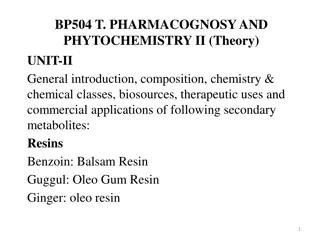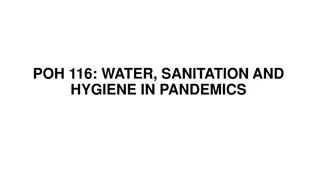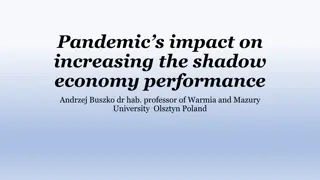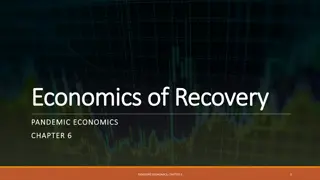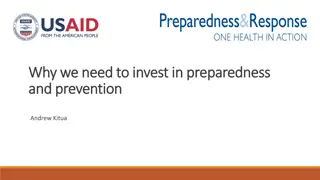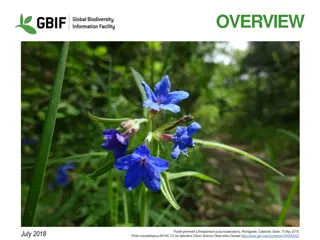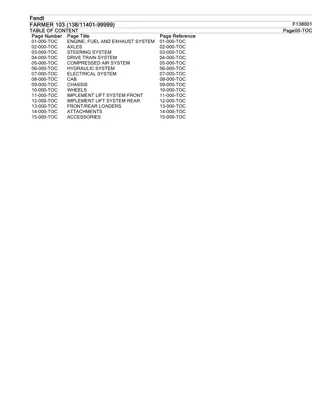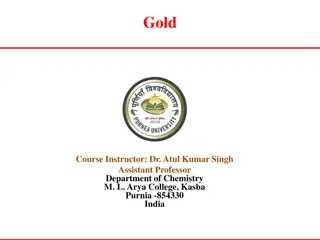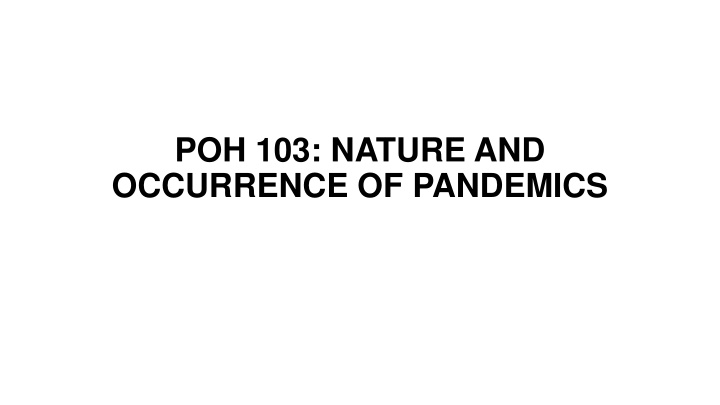
Understanding the Nature and Occurrence of Pandemics
Explore the causation, spread, and control of pandemics in this insightful topic. Learn about disease transmission, host-agent-environment relationships, and principles of pandemic control. Dive into infectious diseases, definitions, Koch's postulates, and more to gain a comprehensive understanding of pandemics.
Uploaded on | 0 Views
Download Presentation

Please find below an Image/Link to download the presentation.
The content on the website is provided AS IS for your information and personal use only. It may not be sold, licensed, or shared on other websites without obtaining consent from the author. If you encounter any issues during the download, it is possible that the publisher has removed the file from their server.
You are allowed to download the files provided on this website for personal or commercial use, subject to the condition that they are used lawfully. All files are the property of their respective owners.
The content on the website is provided AS IS for your information and personal use only. It may not be sold, licensed, or shared on other websites without obtaining consent from the author.
E N D
Presentation Transcript
POH 103: NATURE AND OCCURRENCE OF PANDEMICS
PURPOSE This topic introduces learners to causation, spread and control of pandemics
OBJECTIVES This topic enables learning about: Concepts and nature of pandemics Disease causation and transmission Interrelationship between host, agent, and environment Principles of control of pandemics
Expected Learning Outcomes At the end of this topic, the learner should be able to: Describe concepts and nature of pandemics Explain disease causation and transmission Analyze the interrelationship between host, agent, and environment and Discuss principles of control of pandemics
Introduction to Infectious Diseases Infectious diseases are disorders that are caused by organisms, usually microscopic in size, such as bacteria, viruses, fungi, or parasites that are passed, directly or indirectly, from one person to another. Humans can also become infected following exposure to an infected animal that harbors a pathogenic organism that is capable of infecting humans.
Infectious Diseases - Definitions Disease a pathological condition of body parts or tissues characterized by an identifiable group of signs and symptoms. Infectious disease disease caused by an infectious agent such as a bacterium, virus, protozoan, or fungus that can be passed on to others. Infection occurs when an infectious agent enters the body and begins to reproduce; may or may not lead to disease. Pathogen an infectious agent that causes disease. Host an organism infected by another organism. Virulence the relative ability of an agent to cause rapid and severe disease in a host.
Kochs Postulates Koch developed four criteria to demonstrate that a specific disease is caused by a particular agent. 1. The specific agent must be associated with every case of the disease. 2. The agent must be isolated from a diseased host and grown in culture. 3. When the culture-grown agent is introduced into a healthy susceptible host, the agent must cause the same disease. 4. The same agent must again be isolated from the infected experimental host.
Infectious Disease Agents Most infectious agents that cause disease are microscopic in size and thus, are called microbes or microorganisms. Different groups of agents that cause disease are: -Bacteria -Viruses -Protozoa (Protists) -Fungi -Helminths (Animals) Courtesy of CDC
Three Basic Routes of Transmission Contact - Direct - Indirect Droplet -Larger; don t travel long distances, not infective over time -Spatial separation ( 3 feet) Airborne -Smaller; infective over time and distance
Rationale Transmission of infectious agents requires three elements: 1. A source (or reservoir) of infectious agents 2. A susceptible host with a portal of entry receptive to the agent 3. A mode of transmission for the agent
The Chain of Infection Infectious Agent Bacteria Virus Fungi Susceptible Host Reservoir Patient People Staff Environment Visitor Equipment & Water Portal of Exit Portal of Entry Excretion, secretions, skin, and droplets Mucous Membranes Respiratory & GI Tract Broken Skin Means of Transmission Direct/Indirect Contact Inhalation Airborne
Transmission of Infectious Diseases Agents that cause infectious diseases can be transmitted in many ways. Through the air Through contaminated food or water Through body fluids By direct contact with contaminated objects By animal vectors such as insects, birds, bats, etc. Courtesy of VOA Chinese students wearing masks during a SARS outbreak Courtesy of CDC Aedes aegypti mosquito Known to transmit Dengue fever
Transmission Based Precautions Hand Hygiene Gown Gloves Contact Precautions Hand Hygiene Mask Droplet Precautions Hand Hygiene Negative pressure room PAPR/N-95 Respirator mask Airborne Precautions
Breaking the Chain of Infection Infectious Agent Bacteria Rapid identification, diagnosis, and treatment Virus Fungi Susceptible Host Reservoir Education Environmental Hygiene Disinfection and Sterilization Patient People Recognition of high risk patients Treatment of underlying disease Immunizations Staff Environment Visitor Equipment & Water Hand Hygiene, Personal Hygiene Transmission Based Precautions Aseptic Technique Wound/catheter care Hand Hygiene Control of Excretions & secretions Proper attire Portal of Entry Portal of Exit Mucous Membranes Excretion, secretions, skin, and droplets Respiratory & GI Tract Broken Skin Means of Transmission Hand Hygiene Transmission based precautions Environmental Hygiene Direct & Indirect Contact Inhalation Airborne
Phases of Infectious Disease Incubation period time between infection and the appearance of signs and symptoms. Prodromal phase mild, nonspecific symptoms that signal onset of some diseases. Clinical phase a person experiences typical signs and symptoms of disease. Decline phase - subsidence of symptoms. Recovery phase symptoms have disappeared, tissues heal, and the body regains strength.
Classification of Infectious Disease Duration Acute develops and runs its course quickly. Chronic develops more slowly and is usually less severe, but may persist for a long, indefinite period of time. Latent characterized by periods of no symptoms between outbreaks of illness. By location Local confined to a specific area of the body. Systemic a generalized illness that infects most of the body with pathogens distributed widely in tissues. By timing Primary initial infection in a previously healthy person. Secondary infection that occurs in a person weakened by a primary infection.
How Infectious Agents Cause Disease Production of poisons, such as toxins and enzymes, that destroy cells and tissues. Direct invasion and destruction of host cells. Triggering responses from the host s immune system leading to disease signs and symptoms. Courtesy of CDC Human Immunodeficiency Virus. HIV-1 virions can be seen on surface of lymphocytes.
Reducing the Spread of Infectious Diseases Vaccines Antimicrobial drugs Good personal hygiene and sanitation Quarantine
Emerging Infectious Diseases Emerging diseases are those that have recently appeared within a population, or whose incidence or geographic range is increasing rapidly. Diseases can emerge or re-emerge due to: -Appearance of a previously unknown agent. -Evolution of a new infectious agent. -Spread of an infectious agent to a new host. -Spread of an infectious agent to new locations. -Acquisition of resistance to anti-microbial drugs. -Deliberate introduction into a population.
Review of The Pandemic Preparedness with One Health approach (PPOH) short course is by the East African Community (EAC) Secretariat in cooperation with universities of the six EAC Partner States. It is facilitated by the German Government and implemented by the Deutsche Gesellschaft f r Internationale Zusammenarbeit GIZ GmbH through the Global Programme Pandemic Prevention and Response, One Health (GP PPOH)


